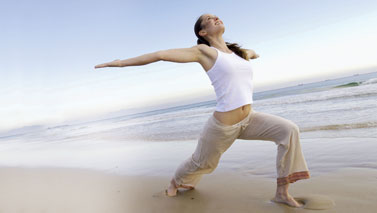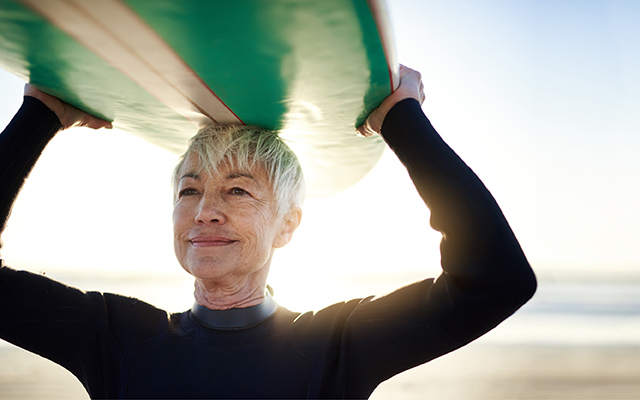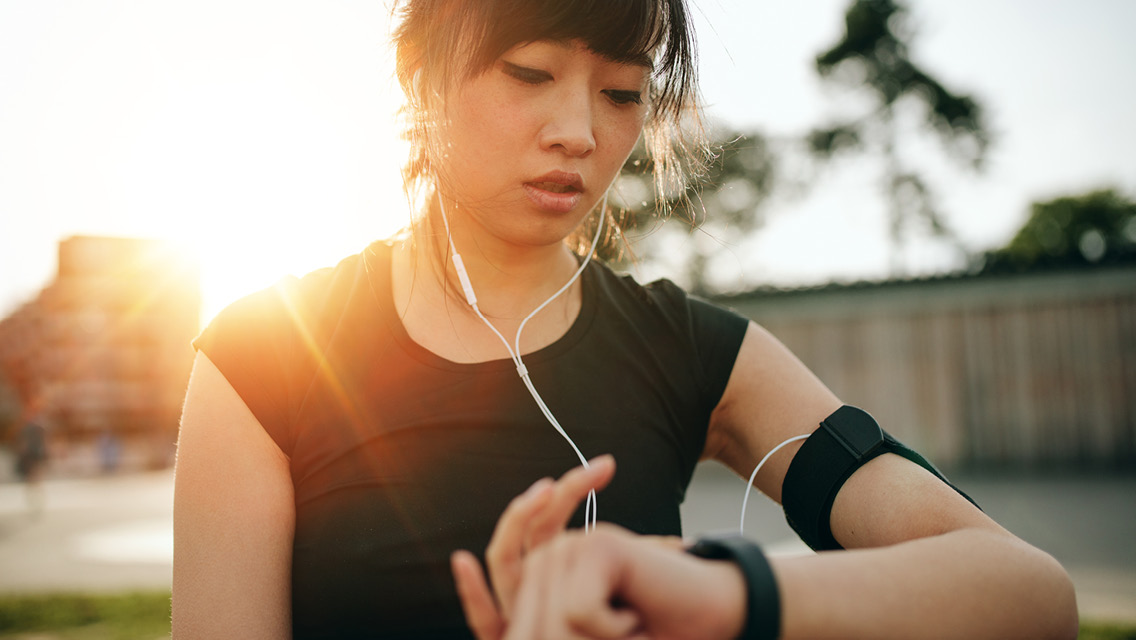My 40th birthday present to myself was a commitment to get back in shape. Having spent the five previous years either pregnant or nursing babies, I wasn’t necessarily fat, but I was certainly squishy. Worse, I got winded just running after my children. As a former high school gymnast and soccer player, I missed the intense satisfaction that comes from pushing yourself to your physical limit. I wanted to reclaim that part of my past.
The summer boot camp I attended later that year gave me what I wanted — and then some. After a morning filled with wind sprints and leg cranks on a park bench (activities I hadn’t even thought about since those days on the soccer field), I threw up. Then I pulled a quad muscle running up a hill. I kept showing up for class, though. And eventually it dawned on me that trying to get back to where I was in high school over the course of two weeks probably wasn’t wise — or remotely necessary.
As the course progressed, I started paying closer attention to what was going on with my body, and when classes came to an end, I was delighted to discover that my desire to pursue a regular fitness routine didn’t.
In fact, what I’d learned about pushing myself to my personal edge (but not beyond it) gave rise to a whole new era of fitness for me. As my attachment to instant fitness transformation relaxed, a new confidence emerged. Visible and dramatic fitness gains would one day be mine, I knew, and in the meantime, I refocused my attention on the subtle but important ways that my body and life were changing for the better — ways that I hadn’t necessarily anticipated.
I was less irritable, for one thing, and I suddenly had more energy than I’d had in years. Losing a night’s sleep to a child’s ear infection didn’t set me back the way it did before I started exercising. I was also coming to cherish the camaraderie that came from working out with a group, and the affirmation my trainers gave me.
Meanwhile, little by little, my body was becoming less soft, my breathing less labored. Exertion levels that used to be beyond my physical limits started coming within a more comfortable reach. The “hard parts” of the workouts were feeling more doable, and previously demanding daily activities began to feel downright easy.
As with so many life goals, becoming fit isn’t just about some mythical “end result.” In fact, the unexpected benefits of fitness — improved energy levels, better concentration and a closer relationship with your body, to name just a few — can prove much more satisfying.
That’s why it’s important to savor all the milestones that occur along your fitness journey, not just the visible ones. Take it stage-by-stage, stay alert, and no matter what your starting point, you’ll soon begin experiencing a variety of subtle, but enjoyable, changes that will keep you motivated for many months to come.
Stage 1 – Escape From Inertia
Most people starting a fitness routine expect to see fast results. But if you’re struggling with extra weight, or you’re not happy about how you look, getting too focused on super-quick, highly visible results can work against you.
While it’s true that those just starting out may notice dramatic changes simply because they’re finally exercising, it’s far more common to feel results before you see them. Focusing on and celebrating early progress — including the simple fact that you’re making time to exercise — is essential to busting through inertia and staying the course until visible changes become more pronounced.
“People often get discouraged when they sense how long it will take to get the results they want,” says Kate Larsen, author of Progress Not Perfection: Your Journey Matters (Expert Publishing, 2006). A better approach, she says, is to “look at the big picture and get encouraged” — by the fact that you’re taking smart, realistic steps toward true progress.
If you’re just getting back into exercise after a long hiatus, be realistic about your capabilities and start where you’re at. Consider working with a personal trainer, doctor or coach who can help you assess your current fitness level. Beginner’s yoga, Pilates mat or group-fitness classes, or even just Nordic walking around your neighborhood, are all great places to start. Using a heart-rate monitor can help you measure your effort level and fitness progress.
But what if you need an extra push to get off the couch? Do a quick review of the values and priorities that got you started down this fitness path in the first place. Reconnect not just with the rewards you’ll enjoy as an outcome of exercise, but with the satisfaction you can get from following through on your commitment to yourself and the priorities you hold dear. Even if you have just 10 minutes for an activity on a given day, do it. Then you can pat yourself on the back for your integrity of intention and effort.
Miriam Nelson, PhD, director of the John Hancock Center for Physical Activity and Nutrition at Tufts University in Boston, Mass., and author of Strong Women, Strong Backs: Everything You Need to Know to Prevent, Treat, and Beat Back Pain (Penguin Books, 2006), recommends scheduling workouts into your calendar and then visualizing yourself completing a great session whenever you look at the appointment entry. If you miss a day or two, don’t dwell on it. Examine why, learn from the experience, then move on and reclaim your momentum.
Once you do have even a few workouts under your belt, you can be on the lookout for benefits like improvements in sleep, energy, mood, self-esteem and mental clarity. “It doesn’t take much to start enjoying the mental benefits of exercise,” says Larsen.
Stage 2—Something’s Different
Once you’ve been in the groove of moving your body for a few weeks or more, your clothes may be fitting differently. But more important, by now you may also be enjoying the way you feel when you work out — at least some of the time — and the physical benefits of your workouts are probably spilling over into other areas of your life.
“You may notice you no longer get winded going up stairs,” says Tom Holland, MS, CSCS, a Darien, Conn.–based exercise physiologist and author of The Marathon Method. “Or that you can pick up your kid or put your luggage in the overhead compartment with less effort.”
You may have a springier step, a healthier glow, and a revived interest in all sorts of activities (including sex). If you’re using a heart-rate monitor, you may also find you’ve dropped a few beats a minute from your midlevel exertion numbers. Whatever you notice, it’s vital you step back and appreciate those changes as evidence of real fitness progress.
As you add more variety to your fitness repertoire, you’ll net more gains, including the confidence that comes from moving out of your comfort zone. That confidence plays out in the other realms of your life, Holland notes. You may feel more sure of yourself at work, or more willing to set boundaries around your time and energy.
That’s important, because this is the stage where people tend to either go overboard with their workouts (courting injury or burnout) or begin losing their momentum because of boredom. The key now is to monitor your energy while continuing to challenge yourself with new goals.
If swimming for 20 minutes makes you feel energized, increase the length of your routine by 10 percent each week. Likewise, if you can do 12 repetitions of a weight exercise without losing your form, it’s time to reach for bigger dumbbells.
Feeling exhausted and cranky during the day, however, are signs that you’re probably overdoing it.
Stage 3—Hit Your Stride
You’ll begin to notice in this stage — from several weeks to a few months in — that your regimen is really starting to pay off. According to Nelson, as you gain muscle mass, your metabolism increases and you burn calories more effectively. Your newfound strength also makes physical activity more fun. You’ll have more energy, and your friends may begin to notice that you not only look taller and thinner, but healthier, too. And they’re right.
“If a doctor had a pill to make you feel better and live longer, he would prescribe it right away,” says Holland. “But that remedy already exists — in exercise.” The exercise you’ve been doing is probably already lowering your blood pressure, increasing your immunity and reducing your risk of type 2 diabetes and other chronic diseases. (Check out “How Exercise Heals” for a more detailed discussion of the medical benefits of fitness.)
If you haven’t already joined a health club, you may want to sign up at this point, because working out is becoming a more central part of your life. You may instinctively be making better nutrition choices in an effort to support your fitness efforts, and if you’re not, this is a great time to start making the shift — you’ll find exercise becomes easier and more rewarding.
This is also when Holland advises his clients to mix it up: “Changing your routine every four to six weeks keeps you mentally stimulated and helps your body to keep changing.” (For how to create a long-term exercise routine, see “Plan for Success”.)
Stage 4—Test Your Limits
Exercising is no longer something you do simply to get slimmer or more buff. In fact, you may be at a point now where if you don’t work out, you feel antsy, moody or just plain “blah.” Because activity has become a regular part of your body’s repertoire, you can (and probably should) start challenging yourself in new ways.
Now that you know what it feels like to “find your edge,” the idea of giving something your full-out effort is less intimidating, more exhilarating. In fact, you might be curious about what your body can do. You’re at the perfect stage to set your sights on training for an event, says Holland. Consider signing up for a 5K, 10K or triathlon — or get involved with a charity cycling or rowing event.
Not the competitive-sports type? Connect with a local running or cycling group, or book yourself into a more advanced group-fitness, group-training or yoga class.
This way, you create opportunities to connect with people who share your passion, says Holland. You keep your fitness experience fresh, and you begin discovering that you can do things you never realized you could.
Stage 5—Claim It
Welcome to the world of your own athleticism. You can now call yourself a runner rather than saying that you run. Fitness is an inextricable part of you.
You might be toying with goals that would have scared you only a year ago. Does this mean your body looks like an Olympian’s? Not necessarily.
Three years after that first boot camp, I can chest-press twice as much as I could then, and I can run 10 miles — but I still don’t have the waistline I would have hoped for. The difference now is that I don’t care that much. I work out six days a week and rely on my runs with friends as much for the emotional support as the physical challenge.
I’ve taken up tennis and am in good enough shape to truly enjoy the game. And even though I’ll never do another back flip, I recall my childhood gymnast every time I master a new challenge. Getting in touch with her reminds me of something I had ignored for too long: I’m an athlete.
Unsung Heroes
The best — and least hyped — benefits of getting fit:
- Speedier recoveries. The healthier you are, the more quickly you recover from accidents and illnesses.
- Improved mood. Working out regularly releases tension, makes you less prone to emotional outbursts and depression — and may even revive a flagging libido.
- Fewer meds. For weight-related medical conditions such as diabetes, getting fit and losing those extra pounds may allow your doctor to lower your medication levels.
- Better eating habits. You may make healthier food choices when you’re on a fitness regimen, and not necessarily because your long-term goal is to lose weight. Rather, you start to see the tradeoffs involved: Gorging on junk food nullifies too many of your workouts’ benefits and doesn’t give you the energy or stamina you need to make your workouts count. Plus, a fit body more effectively regulates your appetite, making it easier to say “no, thanks” to the foods that aren’t in your body’s best interests.
- Better coordination and balance. Most people instinctively prefer to rely on their right arms and left legs. Working out challenges other parts of your body and improves your coordination, which improves your skills for daily activities such as walking on an icy driveway or hoisting bags of groceries.
- Confidence. It’s deeply satisfying to work toward — and then achieve — any goal. Getting fit empowers you to take on other objectives and dreams with gusto.




This Post Has One Comment
[…] her belt. “Then one morning I woke up and thought,I can’t let this virus keep me down. I have tofind the small winsevery […]